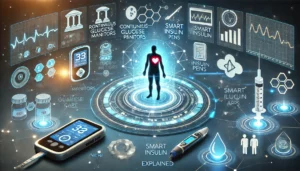Innovative Advances in Smart Insulin and Stem Cell Transplants
The landscape of diabetes treatment is undergoing a radical transformation, thanks to groundbreaking innovations in smart insulin technologies and stem cell transplants. Researchers worldwide are striving to improve the quality of life for those with diabetes by making glucose control more efficient, less invasive, and increasingly adaptable. This blog post delves into the promising research that could redefine diabetes management by 2024 and beyond.
The Promise of Smart Insulin
Smart insulin is emerging as a revolutionary approach aimed at simplifying diabetes management. Unlike traditional insulin therapy, smart insulin is designed to automatically adjust its action based on the body’s glucose levels. This advancement opens doors to a more dynamic and response-based approach to managing insulin needs, reducing the likelihood of both hypo- and hyperglycemic episodes.
What Makes Insulin “Smart”?
- It reacts to blood sugar levels, releasing insulin when glucose is high and reducing release when glucose is low.
- Potential for reduced frequency of blood sugar monitoring.
- Decreases the need for multiple daily insulin injections.
Smart insulin is being engineered with embedded glucose-responsive components that mimic the pancreas’ beta cells, releasing insulin precisely when required. This potential game-changer has been making strides towards clinical application, promising a future that could see individuals with diabetes awake to stable glucose levels without nighttime monitoring or intervention.
Stem Cell Transplants: A Cure on the Horizon
In the quest to regenerate damaged cells, stem cell therapy offers hope not only for management but also with long-term cure implications. Stem cells have the unique ability to differentiate into any cell type, including insulin-producing beta cells. Researchers are now exploring their potential to replace dysfunctional pancreatic cells in individuals with Type 1 diabetes.
The Enabling Power of Stem Cells
- Ability to regenerate and replace damaged pancreatic beta cells.
- Possibility of reducing or eliminating the need for insulin injections.
- Potential to treat the underlying causes of Type 1 diabetes, not just the symptoms.
Recent advancements have shown promise in developing methods to cultivate large quantities of functional beta cells from stem cells, paving the way for a new era in diabetes treatment. When transplanted into patients, these cells have the potential to autonomously regulate insulin production, mimicking a non-diabetic pancreas.
Integrating Innovations into Diabetic Care
While the individual benefits of smart insulin and stem cell transplant are clear, merging these technologies could lead to even greater improvements.
Complementary Benefits
- Possible combination therapies could enhance glucose control while also repairing pancreatic function.
- This duo addresses immediate glucose monitoring and long-term cell regeneration.
- Could significantly impact both Type 1 and Type 2 diabetes management protocols.
Integrating these therapies into mainstream treatment could transform both prevention and intervention strategies, making diabetes management more personalized and efficient.
Barriers and Challenges
Despite their promise, several challenges must be overcome before these treatments can be widely implemented. The development of smart insulin and stem cell-based therapies faces hurdles such as:
Challenges in Development and Deployment
- Ensuring safety and efficacy through rigorous clinical trials.
- Reducing the cost of producing smart insulin and stem cell treatments to make them accessible.
- Overcoming potential immune rejection of transplanted cells.
Collaboration among researchers, healthcare professionals, and policymakers will be essential to tackle these challenges and accelerate progress in this field.
Conclusion: A New Era in Diabetes Management
The advancements in smart insulin and stem cell transplants represent a beacon of hope for millions with diabetes. These innovations are more than just improvements—they hold the potential to redefine diabetes care profoundly. As research progresses and these technologies move toward clinical application, the dream of a world where diabetes becomes a manageable condition, or even a curable disease, edges closer to reality.
Keeping pace with these developments will be crucial for healthcare providers and patients alike, as this era of technological and biological integration unfolds.
“`



